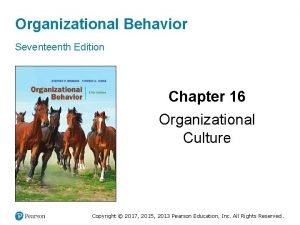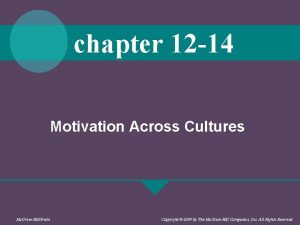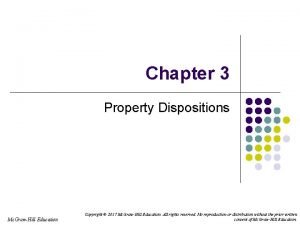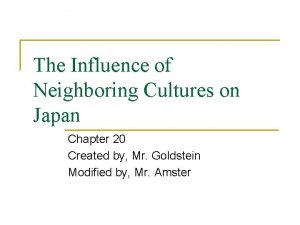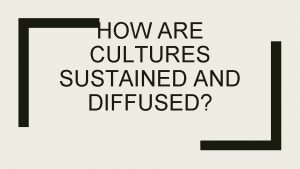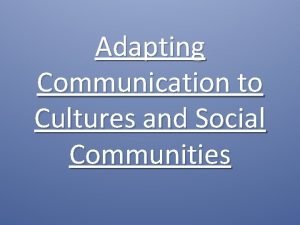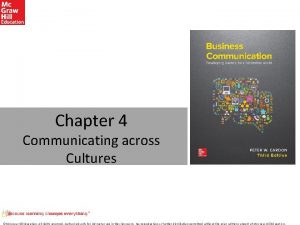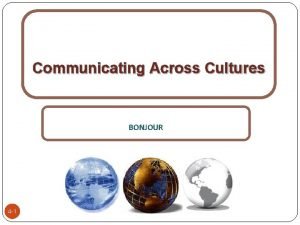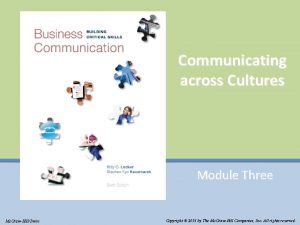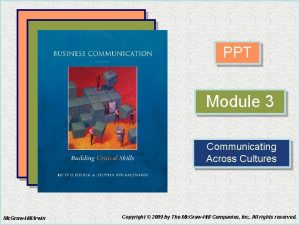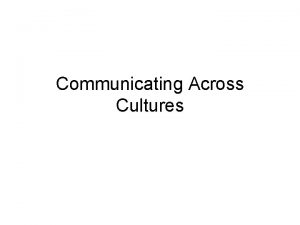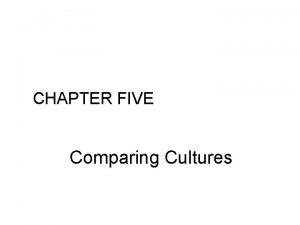Chapter 4 Communicating across Cultures Mc GrawHill Education























































- Slides: 55

Chapter 4 Communicating across Cultures ©Mc. Graw-Hill Education. All rights reserved. Authorized only for instructor use in the classroom. No reproduction or further distribution permitted without the prior written consent of Mc. Graw-Hill Education.

Learning Objectives Learning Objective 4. 1: Describe characteristics of cultural intelligence, its importance for global business leaders, and approaches to developing it. Learning Objective 4. 2: Explain the major cultural dimensions and related communication practices. Learning Objective 4. 3: Name and describe key categories of business etiquette in the intercultural communication process. Learning Objective 4. 4: Identify how generational, gender, and other group differences affect workplace communication. ©Mc. Graw-Hill Education.

Chapter Overview • Characteristics of cultural intelligence • Major cultural dimensions—individualism and collectivism, egalitarianism and hierarchy, assertiveness, performance orientation, future orientation, humane orientation, uncertainty avoidance, and gender egalitarianism • Key categories of business etiquette—appropriate topics of conversation, private or taboo topics, punctuality and meetings, dining, touching and proximity • How group differences affect workplace communication ©Mc. Graw-Hill Education.

Developing Cultural Intelligence (1 of 2) Cultural intelligence (CQ) – A measure of your ability to work with and adapt to members of other cultures ©Mc. Graw-Hill Education.

Developing Cultural Intelligence (2 of 2) Culture – Includes the shared values, norms, rules, and behaviors of an identifiable group of people who share a common history and communication system – There are many types of culture, such as national, organizational, and team. ©Mc. Graw-Hill Education.

Table 4. 2 Cultural Intelligence in the Workplace • • • Characteristics of High Cultural Intelligence Respect, recognize, and appreciate cultural differences. Possess curiosity about and interest in other cultures. Avoid inappropriate stereotypes. Adjust conceptions of time and show patience. Manage language differences to achieve shared meaning. Understand cultural dimensions. Establish trust and show empathy across cultures. Approach cross-cultural work relationships with a learner mindset. Build a co-culture of cooperation and innovation. ©Mc. Graw-Hill Education.

Respect, Recognize, and Appreciate Cultural Differences Cultural intelligence is built on attitudes of respect and recognition of other cultures. This means that you view other cultures as holding legitimate and valid views of and approaches to managing business and workplace relationships. ©Mc. Graw-Hill Education.

Diversity – The presence of many cultural groups in the workplace Business professionals with high cultural intelligence embrace diversity as a moral imperative and as a means to achieve higher performance. ©Mc. Graw-Hill Education.

Be Curious about Other Cultures Study abroad. Learn a language. Develop friendships with international students on your campus. Take an interest in culture and routinely learn about it. ©Mc. Graw-Hill Education.

Take an Interest in a Culture and Routinely Learn about It Watch films, television, documentaries, news, and other video of the culture. Follow the business culture of a country. Take courses and attend events related to particular cultures. Make friends with people who live in other cultures and communicate online. ©Mc. Graw-Hill Education.

Avoid Inappropriate Stereotypes Projected cognitive similarity – The tendency to assume others have the same norms and values as your own cultural group ©Mc. Graw-Hill Education. Outgroup homogeneity effect – The tendency to think members of other groups are all the same

Hardworking Inventive Honest Greedy Rude Canada 77% 76% 42% 62% 53% China 44 70 35 57 44 France 89 76 57 31 36 Germany 67 56 52 49 12 India 81 86 58 43 27 Jordan 78 68 37 63 64 Netherlands 84 69 46 67 26 Russia 72 56 32 60 48 Spain 74 53 45 58 39 UK 76 64 57 62 35 Source: Pew Global Attitude Project Table 4. 3 Perceptions that Members of Various Cultures Have about Americans Note: Dark gray shading indicates a majority of adults in a country have a negative view. Light gray shading indicates a majority of adults in a country have a positive view. ©Mc. Graw-Hill Education. Jump to Appendix 1 long image description

Adjust Your Conceptions of Time People high in CQ show patience. They understand that most tasks take longer when working across cultures because more time is needed to understand one another and cooperate effectively. ©Mc. Graw-Hill Education.

Manage Language Differences Avoid quickly judging that others have limited communication proficiency. Articulate clearly and slow down. Avoid slang and jargon. Give others time to express themselves. Use interpreters as necessary. Jump to Appendix 2 long image description ©Mc. Graw-Hill Education.

Understanding Cultural Dimensions (1 of 2) Cultural dimensions – Fairly permanent and enduring sets of related norms and values ©Mc. Graw-Hill Education.

Understanding Cultural Dimensions (2 of 2) Individualism and collectivism Future orientation Egalitarianism and hierarchy Performance orientation Assertiveness Humane orientation Uncertainty avoidance Gender egalitarianism Jump to Appendix 3 long image description ©Mc. Graw-Hill Education.

Figure 4. 2 Individualism and Collectivism Individualism – A mind-set that prioritizes independence more highly than interdependence, emphasizing individual goals over group goals, and valuing choice more than obligation Jump to Appendix 4 long image description ©Mc. Graw-Hill Education.

Figure 4. 3 Individualism and Collectivism – A mind-set that prioritizes interdependence more highly than independence, emphasizing group goals over individual goals, and valuing obligation more than choice Jump to Appendix 5 long image description ©Mc. Graw-Hill Education.

Table 4. 4 Communication Practices in High Individualist and High Collectivist Cultures High Individualism High Collectivism Discuss individual rewards and goals Discuss group rewards and goals Emphasize opportunities and choices Emphasize duties and obligations Spend less time in group decision making Spend more time in group decision making Socialize infrequently with colleagues outside of work Socialize frequently with colleagues outside of work Network in loosely tied and temporary social networks Network in tightly knit and permanent social networks Communicate directly to efficiently Communicate indirectly to preserve deal with work tasks and outcomes harmony in work relationships ©Mc. Graw-Hill Education.

Egalitarianism and Hierarchy Egalitarian cultures – People tend to distribute and share power evenly, minimize status differences, and minimize special privileges and opportunities for people just because they have higher authority. ©Mc. Graw-Hill Education.

Figure 4. 5 Egalitarianism and Hierarchy Hierarchical cultures – People expect power differences, follow leaders without questioning them, and feel comfortable with leaders receiving special privileges and opportunities. Jump to Appendix 6 long image description ©Mc. Graw-Hill Education.

Table 4. 5 Communication Practices in Egalitarian and Hierarchical Cultures Egalitarianism Hierarchy Decision making is more decentralized. Decision making is more centralized. Protocol based on status is less important and is reserved for unusually formal business situations. Protocol (use of titles, seating arrangements) based on status is extremely important. Subordinates speak more openly with Subordinates defer to leaders during leaders even during disagreements. Subordinates do not take responsibility for the mistakes of leaders. Subordinates take blame for and save face for leaders at all times. Leaders are approached directly. Leaders are approached through intermediaries. ©Mc. Graw-Hill Education.

Figure 4. 6 Performance Orientation Performance orientation (PO) – “The extent to which a community encourages and rewards innovation, high standards, and performance improvement” Jump to Appendix 7 long image description ©Mc. Graw-Hill Education.

Table 4. 6 Communication in High Performance and Low Performance Orientation Societies High Performance Orientation Low Performance Orientation Emphasize results more than relationships Emphasize relationships more than results Prioritize measureable goals and objectives in meetings and communications Discuss goals and objectives casually without mechanisms for measuring them View feedback as essential to improvement View feedback as judgmental and uncomfortable Explicitly talk about financial incentives De-emphasize financial incentives; consider this motivation inappropriate Value statements of individual accountability Value expressions of loyalty and sympathy Expect urgency in communications and emphasize deadlines Show a relaxed view of time and view overemphasis on deadlines as pushy ©Mc. Graw-Hill Education.

Figure 4. 7 Future Orientation Future orientation (FO) – Involves the degree to which cultures are willing to sacrifice current wants to achieve future needs Jump to Appendix 8 long image description ©Mc. Graw-Hill Education.

Table 4. 7 Communication Practices in High and Low Future Orientation Cultures High Future Orientation Low Future Orientation Emphasize control and planning for the future Emphasize controlling current business problems Focus more on intrinsic motivation Focus more on extrinsic motivation Frequently discuss long-term strategies as part of business communications Rarely discuss long-term strategies as part of communications Use flexible and adaptive language Use inflexible and firm language Often mention long-term rewards and Often mention short-term rewards incentives and incentives Appreciate visionary approaches to business problems ©Mc. Graw-Hill Education. Prioritize proven and routine approaches to problems

Figure 4. 8 Assertiveness – Deals with the level of confrontation and directness that is considered appropriate and productive Jump to Appendix 9 long image description ©Mc. Graw-Hill Education.

Table 4. 8 Communication Practices in High- and Low-Assertiveness Cultures High-Assertiveness Cultures Emphasize direct and unambiguous language Low-Assertiveness Cultures Emphasize indirect and subtle language Uncomfortable with silence and speak View silence as communicative and up quickly to fill the silence respectful Prioritize resolving issues over showing respect to others Prioritize showing respect over resolving issues Typically express more emotion Typically express less emotion Use tough, even dominant, language Use tender and pleasant language Stress equality and use competitive language Stress equality and use cooperative language Value unrestrained expression of thoughts and feelings Value measured and disciplined expression of thoughts and feelings ©Mc. Graw-Hill Education.

Figure 4. 9 Humane Orientation Humane orientation (HO) – “The degree to which an organization or society encourages and rewards individuals for being fair, altruistic, friendly, generous, caring, and kind” Jump to Appendix 10 long image description ©Mc. Graw-Hill Education.

Table 4. 9 Communication Styles in High and Low Humane Orientation Cultures High Humane Orientation Low Humane Orientation Express greetings, welcome, concern, Express greetings and welcome in and appreciation in most interactions formal interactions Consider taking time to talk about feelings as critical Consider taking time to talk about feelings as inefficient Volunteer to help others Help others when asked Smile and display other nonverbal signs of welcome frequently Smile and display other nonverbal signs of welcome infrequently ©Mc. Graw-Hill Education.

Figure 4. 10 Uncertainty Avoidance Uncertainty avoidance (UA) – Refers to how cultures socialize members to feel in uncertain, novel, surprising, or extraordinary situations Jump to Appendix 11 long image description ©Mc. Graw-Hill Education.

Table 4. 10 Communication Styles in High and Low Uncertainty Avoidance Cultures High Uncertainty Avoidance Low Uncertainty Avoidance Document agreements in legal contracts Rely on the word of others they trust rather than contractual arrangements Expect orderly communication: keep meticulous records, document conclusions drawn in meetings Expect casual communication: less concerned with documentation and maintenance of meeting records Refer to formalized policies, procedures, and rules as basis for decision making Feel unbound by formalized policies, procedures, and rules when discussing work decisions with others Verify with written communication Verify with oral communication Prefer formality in the majority of interpersonal business interactions Expect informality in most interpersonal business interactions ©Mc. Graw-Hill Education.

Gender Egalitarianism Gender egalitarianism – Deals with the division of roles between men and women in society ©Mc. Graw-Hill Education.

Table 4. 11 Communication Practices in High and Low Gender. Egalitarianism Cultures High Gender Egalitarianism Low Gender Egalitarianism Provide equal professional opportunities to men and women Provide more professional leadership opportunities to men Expect men and women to have the same communication and management styles Expect men and women to communicate in distinct masculine and feminine ways Avoid protocol that draws attention to gender Prefer protocol that draws attention to gender ©Mc. Graw-Hill Education.

Building and Maintaining Cross-Cultural Work Relationships Establish trust and show empathy. Adopt a learner mind-set. Build a co-culture of cooperation and innovation. ©Mc. Graw-Hill Education.

Figure 4. 11 Establish Trust Jump to Appendix 12 long image description ©Mc. Graw-Hill Education.

Figure 4. 12 Fair Play Jump to Appendix 13 long image description ©Mc. Graw-Hill Education.

Adopt a Learner Mind-Set With the learner mind-set, you expect that members of other cultures possess unique types of knowledge and unique approaches to problem solving that will be helpful for shared business interests. The judger mind-set is often referred to as ethnocentrism. Ethnocentrism – The belief that your own culture is superior—that it provides better approaches for solving work problems or dealing with work relationships and contains a better knowledge base to conceptualize work ©Mc. Graw-Hill Education.

Table 4. 13 Etiquette and Customs in the BRIC Countries - Brazil Appropriate Topics of Personal topics, soccer, weather, traffic, cultural events Conversation Private or Taboo Topics of Conversation Politics, poverty, crime, security, deforestation, corruption Punctuality and Meetings Meeting times are relaxed and often start 10 to 15 minutes late. Dining Meals (lunch and dinner) are an important part of building relationships. Careful attention to etiquette: Food is never touched with the hands. Begin meal with the toast: “Saúde. ” Touching and Proximity Frequent and extended touching: handshakes, embraces between friends, kissing on cheeks between women as a greeting, touching arms, standing close to one another during conversation Conversation Style Animated, lively, expressive, lots of interruptions, loud, spontaneous Business Dress Formal business attire is important. Should be stylish, fashionable. For women, dress should be feminine. Titles are used only in formal situations. Gift Giving Gifts generally are not expected on first meeting. A better alternative is to buy a meal. ©Mc. Graw-Hill Education.

Table 4. 13 Etiquette and Customs in the BRIC Countries - Russia Appropriate Topics of Conversation Politics, Russian culture and history, art (if you know a lot about it), current events, books, films Private or Taboo Topics of Conversation Personal life, religion, comparing Moscow and St. Petersburg, comparing Russia to developing countries Punctuality and Meetings are scheduled far in advance. Time is viewed flexibly. Dining Meals (dinners) are often used to finish a deal. Seating arrangements follow protocol. Continental style of using utensils. Hands should always stay above the table. Drinking alcohol is an important part of socializing. Touching and Proximity Touching reserved for greetings and handshakes. Conversation Style Calm, deliberate, careful, metaphorical and symbolic, philosophical, frank Business Dress Brand-name expensive suits Titles First names are appropriate only after a relationship is well established. Gift Giving Gifts are appreciated. Cheap gifts should be avoided. Good gifts include chocolates, dessert items, fine wine. ©Mc. Graw-Hill Education.

Table 4. 13 Etiquette and Customs in the BRIC Countries - India Appropriate Topics of Conversation Family and personal life, politics, cricket, films, economic reforms Private or Taboo Topics of Conversation Religion, Pakistan, poverty, slums, caste system Punctuality and Meetings are scheduled far in advance. Time is viewed flexibly. Dining Meals are important to show hospitality to visitors. Touching and Proximity People stand closer (2 to 2 ½ feet apart) to one another than in North America. Conversation Style Agreeable, friendly, conflict-avoiding Business Dress Men: suit and tie except in warmer climates where more casual. Women: salwar suit. Conservative dress is important. Titles are typically used unless directed otherwise. Gift Giving Gift giving is a sign of friendship. Expensive and leather gifts should be avoided. ©Mc. Graw-Hill Education.

Table 4. 13 Etiquette and Customs in the BRIC Countries - China Appropriate Topics of Conversation Chinese history, art, calligraphy, Chinese food Private or Taboo Topics Taiwan, Tibet, Tiananmen Square, human rights of Conversation Punctuality and Meetings begin on time; arrive at social events on time. Dining Extravagant meals and banquets are an essential part of building relationships. Toasting is an important part of meals. Individual meals rarely served; rather, dishes for the group are provided on a lazy Susan (rotating tray). Touching and Proximity Handshakes and slight bows during greetings. Touching is rare. People commonly sit side by side rather than facing one another during meetings. Conversation Style Modest, reserved, cautious display of emotion, indirect about disagreements Business Dress Conservative suits. Bright colors are avoided. High heels are avoided. Titles are generally used in the workplace. Gift Giving Gift giving is common in first meetings. Gift should be presented with two hands. Expensive gifts are avoided. ©Mc. Graw-Hill Education.

Identities and Workplace Communication Like culture on a global level, different identities can impact workplace communication. Identities include – Generational groups – Gender – Other group identities ©Mc. Graw-Hill Education.

Workplace across Generations Traditionalists – Born between 1925 and 1945 Boomers – Born between 1946 and 1964 Gen X – Born between 1965 and 1981 Gen Y – Born between 1981 and 1999 Gen Z – Born in 2000 or after ©Mc. Graw-Hill Education.

Figure 4. 13 Five Generations in the American Workforce Source: Richard Fry, “Millennials Surpass Gen Xers as the Largest Generation in the U. S. Labor Force, ” Pew Research Center website, May 11, 2015, available at http: //www. pewresearch. org/fact-tank/2015/05/11/millennials-surpass-gen-xers-asthe-largest-generation-in-u-s-labor-force/ 1 c. ©Mc. Graw-Hill Education. Jump to Appendix 14 long image description

Tips for Working with Different Generations Focus on individuals and their professional goals. Recognize the similarities across generations. Pay attention to preferred approaches to communicating. Observe appropriate formality and attire. ©Mc. Graw-Hill Education.

Table 4. 14 Perceived Strengths and Weaknesses of Millennials in the Workplace (1 of 2) (numbers refer to percentage of respondents who agreed that professionals of each generation exhibited these traits) Strength or Weakness Boomers Gen X Gen Y Tech Savvy 27 77 85 Adaptability 36 67 69 Diversity 42 68 69 Enthusiastic 38 64 68 Entitled and concerned primary about individual promotion 32 51 68 Entrepreneurial 55 71 68 Brand ambassador 39 65 67 Note: Based on 2013 survey of 1, 215 professionals. Source: EY, “Survey Shows Younger Mangers Rise in the Ranks, ” 2013, EY website, available at http: //www. ey. com/Publication/vw. LUAssets/EYSurvey_shows_younger_managers_rising_in_the_ranks/$FILE/Executive-Summary-Generations-Research. pdf. ©Mc. Graw-Hill Education.

Table 4. 14 Perceived Strengths and Weaknesses of Millennials in the Workplace (2 of 2) (numbers refer to percentage of respondents who agreed that professionals of each generation exhibited these traits) Strength or Weakness Boomers Gen X Gen Y Collaboration 54 70 63 Lacking relevant experience 14 15 58 Relationship builder 71 72 54 Flexibility 53 63 47 Communication skills 72 71 42 Hardworking 73 69 39 Decision making 74 70 38 Note: Based on 2013 survey of 1, 215 professionals. Source: EY, “Survey Shows Younger Mangers Rise in the Ranks, ” 2013, EY website, available at http: //www. ey. com/Publication/vw. LUAssets/EYSurvey_shows_younger_managers_rising_in_the_ranks/$FILE/Executive-Summary-Generations-Research. pdf. ©Mc. Graw-Hill Education.

Gender and Communication Patterns Differences still exist in the way men and women communicate. Women tend to be more relationship oriented, collaborative, and interconnected in thinking. Men tend to be more independent, competitive, and linear in thinking. ©Mc. Graw-Hill Education.

Fig 4. 14 Gender in Individualist and Collectivist Societies Source: Chart created by author based on dozens of research studies that demonstrate women tend to exhibit more collectivist, relational attitudes and behaviors in collectivist and individualist societies. ©Mc. Graw-Hill Education. Jump to Appendix 15 long image description

Speech Patterns Associated with Women • Asking questions • Apologizing • Sharing credit • Giving feedback • Avoiding verbal opposition • Being indirect to subordinates • Complimenting ©Mc. Graw-Hill Education.

Tips for Communicating across Genders Notice when professionals use speech patterns for task -based versus relationship-based reasons. Purposefully and consciously adopt your own style. Do your part to overcome biases. ©Mc. Graw-Hill Education.

Display Cultural Intelligence with Other Groups Types of cultural groups include – People from certain regions – People from urban, suburban, or rural areas – Ethnic groups – Occupational groups – Companies ©Mc. Graw-Hill Education.

Chapter Takeaways • Characteristics of cultural intelligence • Major cultural dimensions—individualism and collectivism, egalitarianism and hierarchy, assertiveness, performance orientation, future orientation, humane orientation, uncertainty avoidance, and gender egalitarianism • Key categories of business etiquette—appropriate topics of conversation, private or taboo topics, punctuality and meetings, dining, touching and proximity • How group differences affect workplace communication ©Mc. Graw-Hill Education.

Business Communication Chapter 4 The End ©Mc. Graw-Hill Education. All rights reserved. Authorized only for instructor use in the classroom. No reproduction or further distribution permitted without the prior written consent of Mc. Graw-Hill Education.
 Communicating across cultures - ppt
Communicating across cultures - ppt Organizational cultures often reflect national cultures.
Organizational cultures often reflect national cultures. Communicating vs non communicating hydrocele
Communicating vs non communicating hydrocele Recreational activities across cultures and genders
Recreational activities across cultures and genders Body language across cultures respuestas
Body language across cultures respuestas Motivation across cultures
Motivation across cultures Motivation across cultures
Motivation across cultures Motivation across cultures
Motivation across cultures High context vs low context culture ppt
High context vs low context culture ppt Grawhill
Grawhill Grawhill
Grawhill Grawhill
Grawhill Grawhill
Grawhill Mc graw hill
Mc graw hill Single user multitasking os
Single user multitasking os Grawhill
Grawhill Mc grawhill
Mc grawhill Grawhill
Grawhill Chapter 20:2 obtaining and handling cultures
Chapter 20:2 obtaining and handling cultures Chapter 5 a clash of cultures
Chapter 5 a clash of cultures Chapter 5 section 1 cultures of the mountains and the sea
Chapter 5 section 1 cultures of the mountains and the sea Chapter 13 section 1 cultures clash on the prairie
Chapter 13 section 1 cultures clash on the prairie The collision of cultures chapter 1
The collision of cultures chapter 1 Chapter 4 communicating for success
Chapter 4 communicating for success Voicemail message personal
Voicemail message personal Sub cultures
Sub cultures Which cultures believe in reincarnation
Which cultures believe in reincarnation Examining social life
Examining social life In what ways did neighboring cultures influence japan?
In what ways did neighboring cultures influence japan? Judaism founder
Judaism founder River valley civilizations religion
River valley civilizations religion Which cultures believe in reincarnation
Which cultures believe in reincarnation Small cultures
Small cultures Taste different cultures
Taste different cultures What is culture
What is culture Collectivistic cultures
Collectivistic cultures Personal sense of identity
Personal sense of identity Which cultures believe in reincarnation
Which cultures believe in reincarnation All cultures undergo
All cultures undergo How many cultures are there
How many cultures are there How are local cultures sustained
How are local cultures sustained High-context cultures emphasize nonverbal messages.
High-context cultures emphasize nonverbal messages. Words from many cultures weslandia answers
Words from many cultures weslandia answers Broth cultures
Broth cultures Pengertian transmisi budaya
Pengertian transmisi budaya Indulgence vs restraint hofstede examples
Indulgence vs restraint hofstede examples Georgia's prehistoric cultures chart
Georgia's prehistoric cultures chart Chapter 4 lesson 5 urban geography
Chapter 4 lesson 5 urban geography Social communities include a number of cultures
Social communities include a number of cultures Atakapans
Atakapans Transrasial
Transrasial Pure method
Pure method Cultures and organizations software of the mind
Cultures and organizations software of the mind Cesar chavez adjectives
Cesar chavez adjectives Poetry from different cultures
Poetry from different cultures Knorr cetina epistemic cultures
Knorr cetina epistemic cultures

